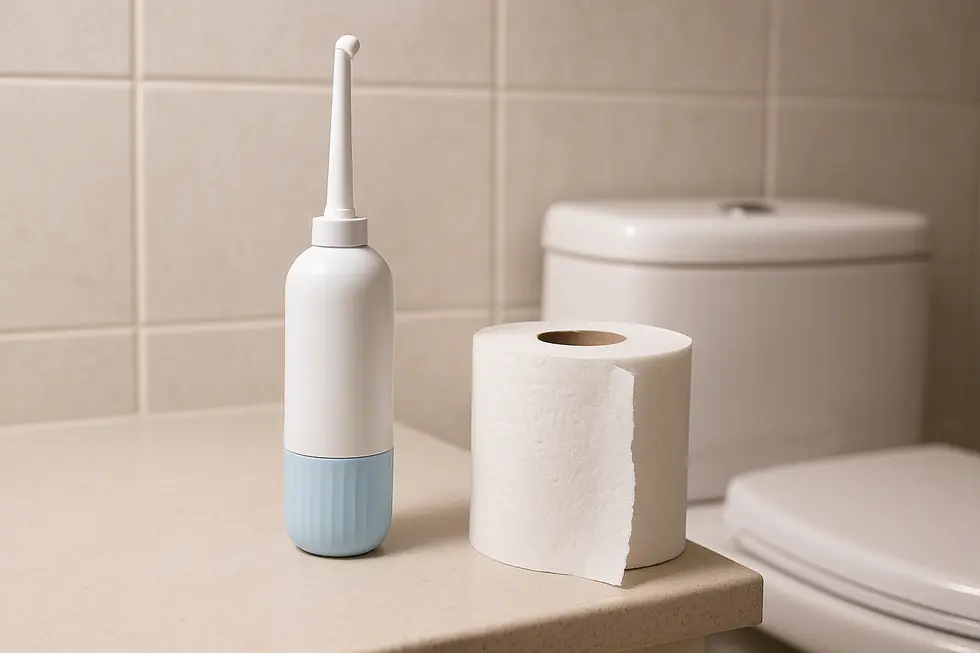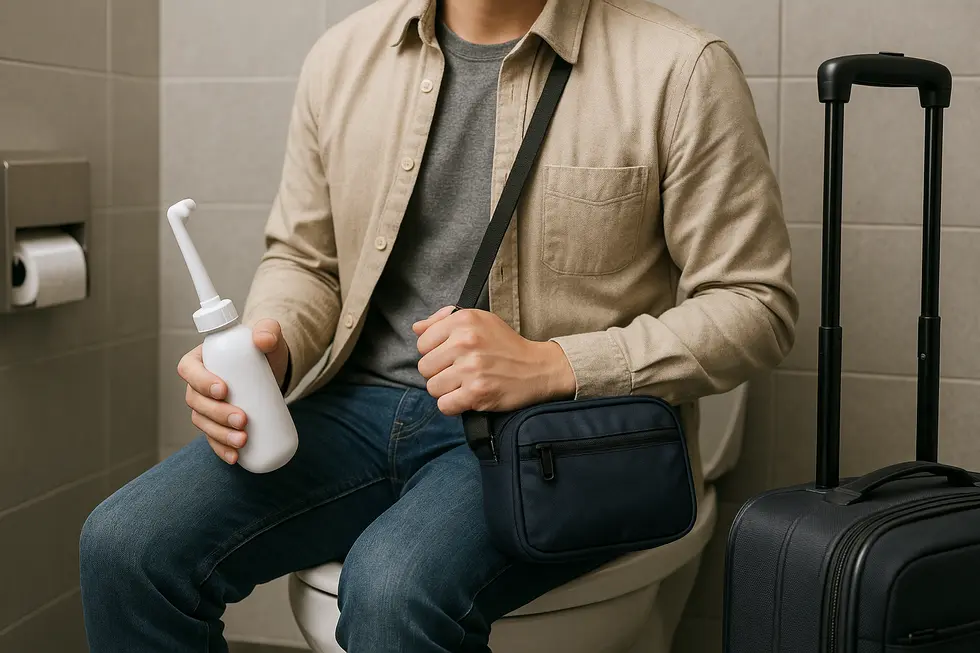Portable Bidet
Portable Bidet vs Toilet Paper: A Deep Dive into Modern Hygiene
In the quest for optimal personal hygiene, the choice between portable bidets and toilet paper emerges as a significant decision for many adults today. Beyond mere personal preference, this decision involves considerations of effectiveness, environmental impact, and convenience—factors that influence not only our personal wellbeing but also our ecological footprint. Each chapter in this exploration peels back the layers on these crucial aspects, offering a comprehensive perspective. Whether it’s evaluating the thoroughness of hygiene practices, understanding environmental responsibilities, or embracing the convenience of modern-day solutions, the discussion herein aims to inform and inspire a more thoughtful approach to hygiene.
A Clean Sweep: Effectiveness and Hygiene of Portable Bidets Over Traditional Toilet Paper

Portable bidets and toilet paper are both tools aimed at achieving the same goal: effective post-toilet hygiene. However, their methods and results are notably distinct. In terms of hygiene, portable bidets offer a marked advantage. The use of water provides a thorough clean, significantly more effective than toilet paper’s dry wipe. For individuals with sensitive skin or conditions like hemorrhoids, this can be a game-changer, as it minimizes irritation and lowers the risk of infection due to its gentle nature.
A key hygiene benefit of portable bidets is their ability to reduce the spread of bacteria. Unlike toilet paper, which can leave residue and cause abrasions that lead to further bacterial growth, water cleanses entirely without harsh contact, minimizing friction and reducing the transfer of bacteria. This is especially advantageous for individuals prone to conditions such as urinary tract infections (UTIs), as it helps maintain better hygiene without the roughness associated with repeated wiping.
Another aspect worth noting is the consistent cleanliness offered by portable bidets. Many models come with adjustable pressure settings, ensuring that users can customize their experience for comfort and efficiency. This contrasts with toilet paper, where effectiveness is dependent on the quality and technique used, which can vary greatly. Despite being widely available and convenient, toilet paper does not offer the same level of thoroughness as its water-based counterpart.
In the realm of environmental impact, the benefits of portable bidets become even more compelling. While both systems use water, the volume required by a portable bidet is much lower than that needed for toilet paper production. The reduction in resource consumption leads to less deforestation and waste generation, making portable bidets a sustainable choice for eco-conscious individuals.
For travelers and those in need of portable solutions, bidets come in lightweight and versatile designs, highly accessible for various settings. This not only supports those with mobility challenges but also adapts to any destination lacking reliable sanitary facilities. While initial investments in portable bidets may vary, their long-term benefits, both hygienic and environmental, present a compelling case for their adoption. For further insights on travel-friendly portable bidet options, visit best travel squeeze bottle bidet advantages.
The Greener Choice: Environmental Impacts of Portable Bidets Compared to Toilet Paper

As concerns over climate change and environmental degradation mount, everyday choices, including personal hygiene practices, are drawing increased scrutiny for their ecological impacts. When it comes to the environmental ramifications of toilet habits, portable bidets emerge as a prime example of how small shifts can have notable benefits. The traditional reliance on toilet paper not only perpetuates a cycle of deforestation but also demands vast resources in its production, leaving a heavy environmental footprint. Conversely, portable bidets present a sustainable alternative, nuanced in their capacity to minimize ecological harm.
The production of toilet paper demands a substantial amount of natural resources, prominently featuring trees and water. It’s an industrial process hinged on deforestation, consuming millions of trees annually. Beyond the stark reality of tree loss, the energy and water expense associated with manufacturing toilet paper compounds the environmental burden. On average, a single roll of toilet paper can consume up to 37 gallons of water throughout its production lifecycle. Such figures paint a stark picture of ongoing natural resource depletion tied directly to personal hygiene practices.
In contrast, portable bidets sidestep these resource-intensive processes by offering a water-based method of cleaning that requires a fraction of the water used in the production of toilet paper. Typically operating with just 0.1 to 0.2 gallons of water per use, portable bidets not only conserve water but also sidestep the pollution and energy toll exacted by traditional paper production. Moreover, they eliminate the need for wet wipes, often made from persistent synthetic materials, notorious for clogging sewer systems and expanding landfill mass.
Globally, the cultural landscape around hygiene is diversifying, with growing acceptance of water-based cleaning methods. Nations with historically low toilet paper usage, spanning much of Asia, the Middle East, and South America, exemplify the environmental efficiencies achievable through such practices. Portable bidets introduce this efficiency more broadly, particularly into Western contexts where toilet paper reliance has been notably high. As societies become more environmentally conscious, incorporating portable bidets symbolizes a strategic pivot towards sustainable living. This enduring shift promises a reduction in deforestation and the preservation of water resources, aligning daily habits with ecological best practices. For a deeper dive into the many advantages of bidets, explore portable bidet benefits.
Embracing Portability and Accessibility: A New Era of Personal Hygiene

When discussing the convenience and accessibility of portable bidets versus toilet paper, it’s essential to acknowledge the transformative potential that portable bidets offer. These compact devices have steadily gained traction for their remarkable portability. Travelers, campers, and adventurers often face the challenging reality of inadequate facilities, where relying solely on toilet paper can be insufficient. Portable bidets, however, offer a solution that easily fits into one’s luggage, providing a consistent means of maintaining hygiene on the go. Unlike toilet paper, which can be bulky depending on the necessary supply, a portable bidet occupies minimal space while ensuring a more effective clean.
The accessibility advantage of portable bidets extends beyond just travel convenience. For individuals with mobility issues, the ease with which these devices can be operated is a game-changer. The simple yet efficient design allows users, including seniors and those with physical disabilities, to maintain personal hygiene independently, thereby enhancing their overall quality of life. In many cultural contexts where water is preferred over paper for cleanliness, portable bidets seamlessly fill this gap, allowing users to maintain their preferred hygiene practices even when far from home. This adaptability is particularly notable in public and shared restrooms, where toilet paper might not always be stocked, and maintaining consistent hygiene practices can be challenging.
From an environmental standpoint, portable bidets also present a compelling case. While the initial perception might be that they require more water than toilet paper, the reality is that the water consumption of a bidet is markedly less when compared to the vast amounts needed for producing and processing toilet paper. Economically, the portable bidet is a savvy investment. Although there is an upfront cost, the significant reduction in toilet paper usage over time translates to monetary savings. For more insights into the benefits of travel squeeze bottle bidets, explore the innovative advantages.
Ultimately, the transition to portable bidet use is more than a preference—it’s a movement towards efficient personal hygiene. While toilet paper remains a universally accessible tool, the enhanced hygiene, environmental benefits, and economical advantages make portable bidets an increasingly popular choice for discerning users across the globe.
Final thoughts
The exploration of portable bidets versus toilet paper reveals compelling reasons to reconsider our hygiene practices. Portable bidets not only enhance personal cleanliness but significantly reduce environmental strain and offer unmatched convenience, especially for travelers. These factors collectively highlight a modern, efficient approach to personal care, urging individuals to make informed choices that benefit both personal health and the planet.
Experience a new standard of clean with PEGABidet—designed for comfort, safety, and independence. Join thousands who trust us to make personal care simple and dignified. Contact us at contact@pegabidet.com
About us
PEGABidet is a brand owned by L.A NEXTGEN LLC, based in California. We design intuitive, hygienic, and accessible bathroom solutions that prioritize safety, dignity, and independence. Our mission is to make personal care effortless and empowering for people at every stage of life.

